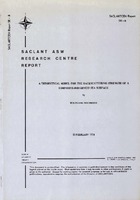| dc.contributor.author | Bachmann, Wolfgang | |
| dc.date.accessioned | 2018-10-11T14:06:27Z | |
| dc.date.available | 2018-10-11T14:06:27Z | |
| dc.date.issued | 1974/02 | |
| dc.identifier | 1785 | |
| dc.identifier.govdoc | SR-5 | |
| dc.identifier.uri | http://hdl.handle.net/20.500.12489/248 | |
| dc.description.abstract | The surface-backscattering strength is calculated according to Rayleigh theory for surface excursions much smaller than the sound wavelength. By taking into account of self-shadowing and modulation of grazing angles, the validity of the result is extended to arbitrary roughness. The predictions of this new composite-roughness scattering model are compared with a small set of experiment data. | |
| dc.format | 5 p. : ill. | |
| dc.language | English | |
| dc.publisher | NATO. SACLANTCEN | |
| dc.source | In: Journal of the Acoustical Society of America, vol. 54 , no. 3, 1973, pp. 712-716. | |
| dc.subject | Acoustic scattering - Seafloor and sea surface | |
| dc.subject | Acoustic models | |
| dc.subject | Modelling and environmental measurements | |
| dc.title | A theoretical model for the backscattering strength of a composite roughness sea-surface | |
| dc.type | Papers and Articles | |
| dc.type | Scientific Report (SR) | |
